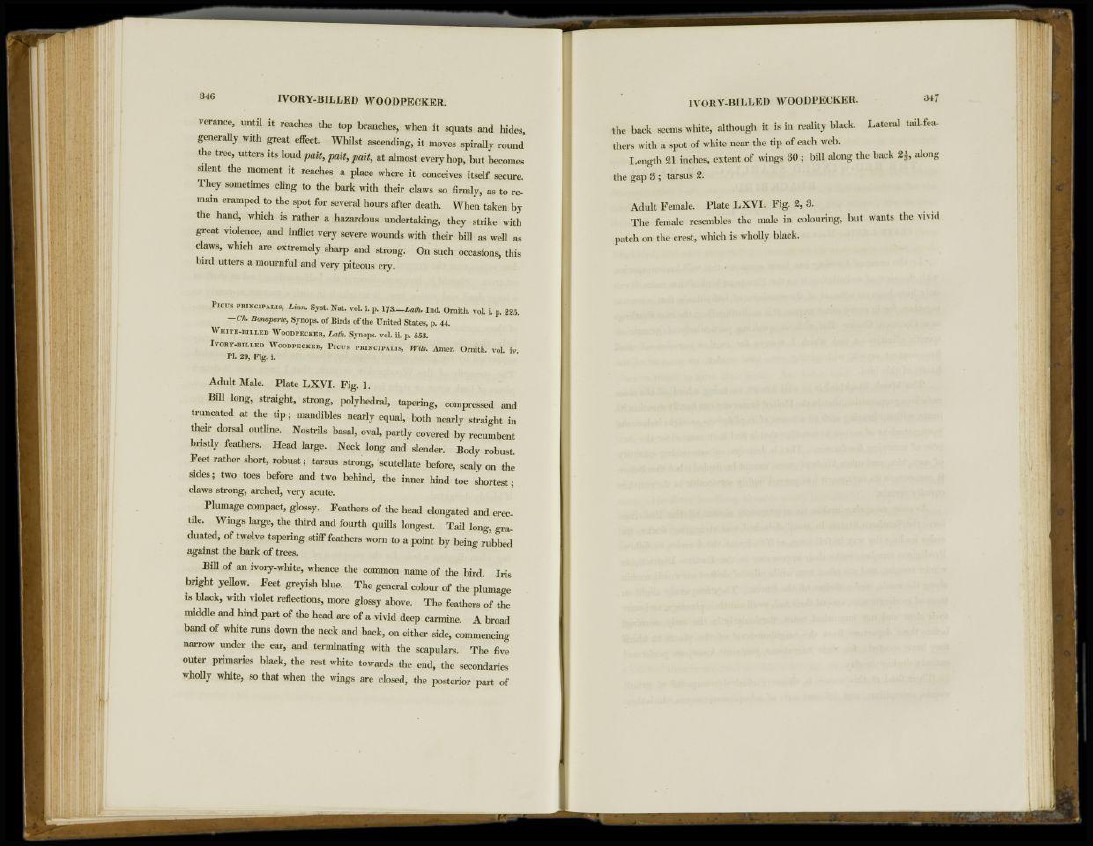
verance, until it reaches the top branches, when it squats and hides,
generally with great effect. Whilst ascending, it moves spirally round
the tree, utters its loud pait, pait, pait, at almost every hop, but becomes
silent the moment it reaches a place where it conceives itself secure.
They sometimes cling to the bark with their claws so firmly, as to remain
cramped to the spot for several hours after death. When taken by
the hand, which is rather a hazardous undertaking, they strike with
great violence, and inflict very severe wounds with their bill as well as
claws, which are extremely sharp and strong. On such occasions, this
bird utters a mournful and very piteous cry.
Picus PRINCIPALIS, Linn. Syst. Nat. vol. i. p. 173—Lath. Ind. Ornith. vol i. p. 225.
—Ch. Bonaparte, Synops. of Birds of the United States, p. 44.
WHITE-BILLED WOODPECKER, Lath. Synops. vol. ii. p. 553.
IVORY-BILLED WOODPECKER, PICUS PRINCIPALIS, Wits. Amer. Ornith. vol. iv.
PI. 29, Fig. i.
Adult Male. Plate LXVI. Fig. 1.
Bill long, straight, strong, polyhedral, tapering, compressed and
truncated at the t i p ; mandibles nearly equal, both nearly straight in
their dorsal outline. Nostrils basal, oval, partly covered by recumbent
bristly feathers. Head large. Neck long and slender. Body robust.
Feet rather short, robust; tarsus strong, scutellate before, scaly on the
sides; two toes before and two behind, the inner hind toe shortest;
claws strong, arched, very acute.
Plumage compact, glossy. Feathers of the head elongated and erectile.
Wings large, the third and fourth quills longest. Tail long, graduated,
of twelve tapering stiff feathers worn to a point by being rubbed
against the bark of trees.
Bill of an ivory-white, whence the common name of the bird. Iris
bright yellow. Feet greyish blue. The general colour of the plumage
is black, with violet reflections, more glossy above. The feathers of the
middle and hind part of the head are of a vivid deep carmine. A broad
band of white runs down the neck and back, on either side, commencing
narrow under the ear, and terminating with the scapulars. The five
outer primaries black, the rest white towards the end, the secondaries
wholly white, so that when the wings are closed, the posterior part of
the back seems white, although it is in reality black. Lateral tail-feathers
with a spot of white near the tip of each web.
Length 21 inches, extent of wings 30; bill along the back 2$, along
the gap 3 ; tarsus 2.
Adult Female. Plate LXVI. Fig. 2, 3.
The female resembles the male in colouring, but wants the vivid
patch on the crest, which is wholly black.